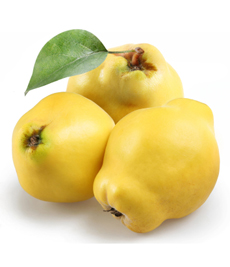TIP OF THE DAY: Bake A Quince Tart
|
Quince are pear-green when unripe. When |
The tree of knowledge in the Garden of Eden may have been quince, not apple. The book of Genesis does not name the specific type of fruit that Eve picked and shared with Adam. Cultivation of quince may have preceded apple cultivation, and many early references that have been translated as “apple” may in fact have been quince.
Native to the Caucasus, the mountain range that separates Europe and Asia, quince is related to both the apple and the pear. It looks like a combination of the two, or a large, lumpy pear. The fruit can easily grow to six inches in length. The plural form of the word is the same as the singular—quince, not quinces. Most varieties of quince are too hard and astringent to be eaten raw. Instead, they are used to make jam, jelly, quince pudding, pies and tarts. Adding a dice of quince to applesauce and apple pies enhances the flavor and texture. The white flesh turns red after a long cooking time. |
|
|
Cooked, quince become flavorful and aromatic. They can be baked, braised, poached or stewed and served as a dessert or a side with meat and poultry. The word “marmalade,” which originally meant quince jam, derives from “marmelo,” the Portuguese word for quince. The form of quince we personally eat most often—membrillo—is a quince paste (crema de membrillo) enjoyed with Spanish cheeses. (If you see it, buy it—it couldn’t be more delicious.) Buying & Storing Quince Store quince in a plastic bag in the refrigerator; they’ll keep for several weeks. Once ripe, the skin will turn from green to yellow, but the fruit will still be firm (and in need of cooking). Quince should be peeled before cooking. Celebrate fall by making this Quince Tart Tatin, a recipe from one of our favorite chefs, Charlie Palmer. Find more of our favorite pie recipes in our Pie & Pastry Section.
|
||



